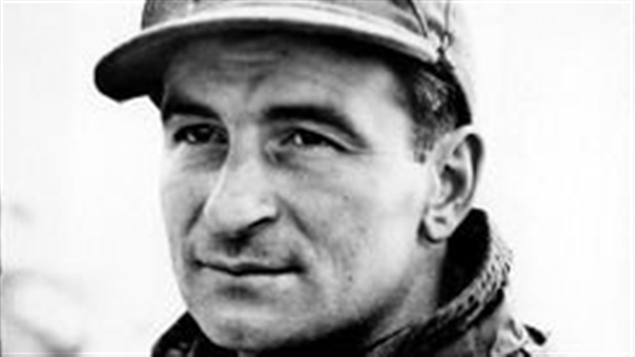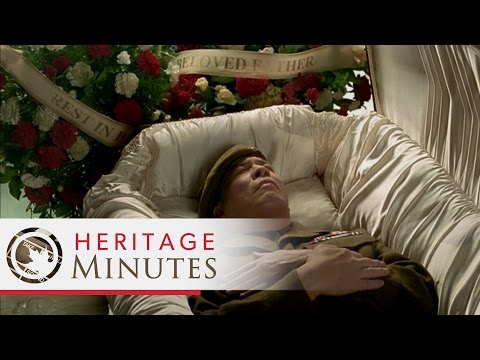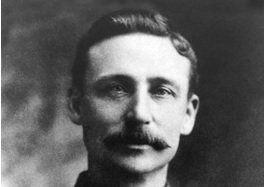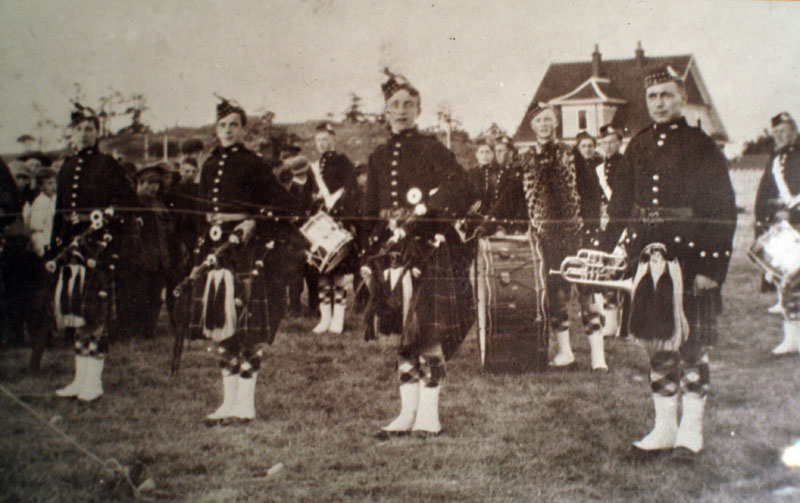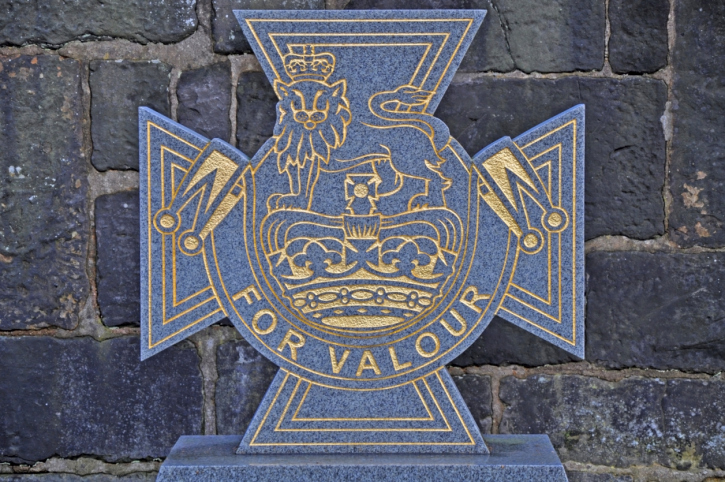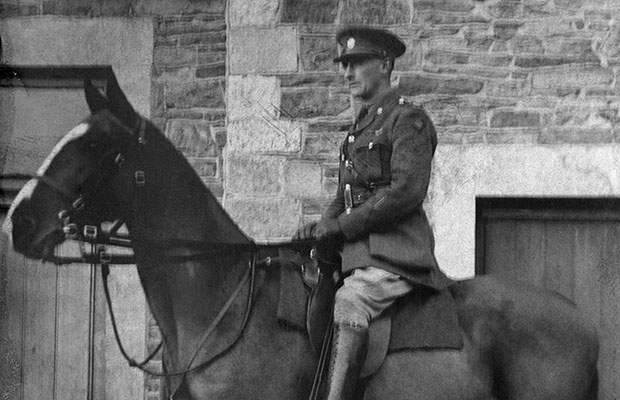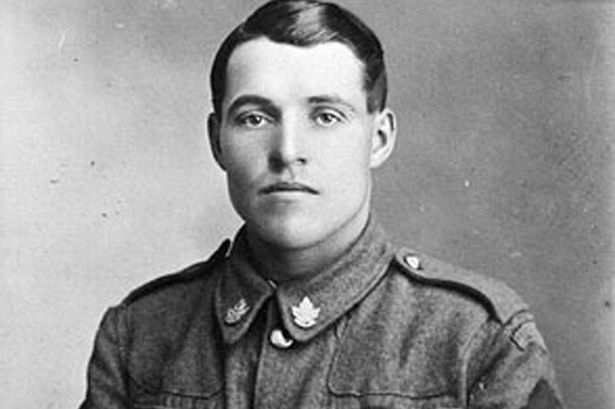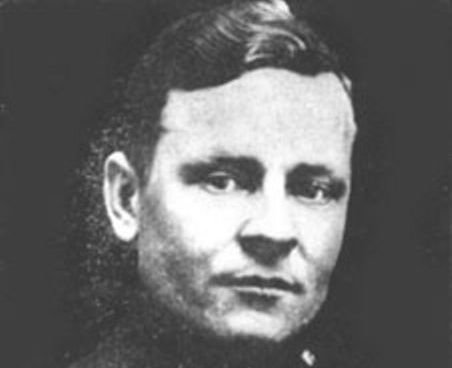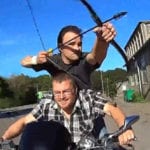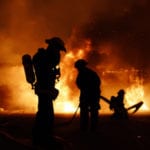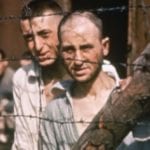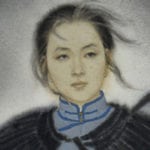10Ernest “Smokey” Smith
With a reputation as a hellraiser, Ernest “Smokey” Smith had a knack for annoying his superiors—he was promoted to corporal and then demoted back to private nine times. But when it came to battle, he more than earned his reputation as one of Canada’s greatest soldiers. In October 1944, as the Allies were pushing through northern Italy against fierce German resistance, Smith and his small platoon were sent across the flooded Savio river to secure an important beachhead. After capturing the position, they came under an intense enemy counter-attack. The Germans dispatched three Panther tanks, self-propelled artillery guns, and a horde of infantry to retake the position, pinning the Canadians down near the river. Smith didn’t waste any time—he grabbed his PIAT anti-tank bazooka and sprang into action. Under intense enemy fire, he walked to within 10 meters (33 ft) of the first Panther tank and took it out with a single shot. Once the Germans had overcome their surprise at Smith’s audacity, they sent 10 infantrymen to get rid of him. Unfazed, Smith grabbed his Tommy gun and stood his ground, killing four of the enemy and forcing the remainder to retreat. He continued to hold his position while defending a wounded comrade, forcing additional German forces to “withdraw in disorder,” before carrying his friend to safety. His platoon was so inspired by his example that they were able to hold the Germans back, securing the beachhead. Hilariously, the army later had to lock Smokey in an Italian post office overnight, just to make sure the “wild man” wouldn’t vanish before being flown to London to meet the King and receive the Victoria Cross. Years later, he cheerfully confirmed his crazy reputation: “Oh, yeah. I didn’t take orders. I didn’t believe in them.”
9Leo Major
Leo Major’s story is so preposterous that Hollywood still hasn’t made a movie about it. A French-Canadian who saw action in the Normandy landings, Leo began his military career by capturing an armored vehicle full of communications equipment, providing the Allies with invaluable intelligence. He then single-handedly took out a group of elite Nazi SS troops, but lost his left eye after a dying enemy managed to ignite a phosphorus grenade. When a doctor tried to send him home, Leo reportedly replied that he only needed one eye to aim. He later broke several bones in his back, but again refused to be evacuated, returning to the battlefield to participate in the liberation of Holland. During an early-morning reconnaissance mission at the Battle of the Scheldt, he spotted a German contingent in a village, most of them asleep. A typical soldier would have returned to report to a superior, but for a guy like Leo this was an opportunity. He captured the German commander, and after killing a few soldiers, the entire company of 93 men surrendered to him. He then escorted them back to the Allied lines. Seriously, you can’t make this stuff up. But Leo’s greatest feat was still to come. In April 1945, the Canadians were tasked with liberating the Dutch city of Zwolle. Their plan was to bombard the German positions with artillery until they surrendered. Leo was once again sent on a reconnaissance mission, this time with a friend. His superiors really should’ve known better. Realizing that an artillery barrage would also kill innocent civilians, Leo and his buddy Willie decided to liberate the city all by themselves. Unfortunately, around midnight, Willie was shot and killed. Enraged, Leo grabbed his friend’s weapon and gunned down two Germans, with the others fleeing in terror. He then proceeded to capture a different German vehicle and forced the driver to bring him to an enemy officer at a nearby tavern. Leo then informed the surprised officer that the town was surrounded by an overwhelming Canadian force and that an attack was imminent, before strolling out of the tavern and disappearing into the night. The next step was to convince the Germans that what he had told the officer was true. Leo spent the rest of the night racing around the town, gunning down Nazis and throwing grenades like a one-man army. After seeing their comrades gunned down by a mad Canadian in an eyepatch, most enemy soldiers made the smart choice and surrendered. As the night wore on, Leo kept appearing at the Allied lines with groups of confused German prisoners—before returning to the city. His final feat was to clear out the local SS headquarters. By 4:00 AM, the Germans had abandoned the town. The artillery attack was canceled, the city saved by a single man. Leo received numerous medals for his deeds in World War II, and earned even more in Korea. Leo Major died in 2008, but his memory lives on in Zwolle, where he is regarded as a hero.
8Tommy Prince
Born into the Brokenhead Ojibwa band, Tommy Prince became a Canadian hero at a time when Aboriginal people were still discriminated against by the government. During World War II, Prince enrolled in the 1st Canadian Special Service Battalion. As the name suggests, the group was one of the first modern special forces units, performing highly dangerous missions behind enemy lines. They were arguably the closest real-world counterpart to Quentin Tarantino’s Inglorious Basterds. Watch this video on YouTube Prior to deployment, the team trained rigorously in stealth tactics, hand-to-hand combat, the use of explosives, amphibious assaults, and alpine warfare. Prince’s particular role was to scout forward and observe enemy movements. His unit terrified Axis soldiers, who called them “the Black Devils” because of their ability to sneak behind enemy lines and slit throats under the cover of darkness. As one of Prince’s officers recalled: “He moved like a shadow. Sometimes, instead of killing the Germans, he’d steal something from them. Other times, he’d slit their throats and not make a sound.” One of Prince’s most famous stunts came in Italy, in 1944. Dressed as a farmer, he set up an observation post in an abandoned house only 200 meters (656 ft) from a German camp. He would report on German movements via a communications wire, and the positions would then be struck by artillery. Unfortunately, the wire eventually became damaged by the shelling. Completely unfazed, Prince grabbed his farming tools and walked out in full view of the Germans. Pretending to be a local working his field, he walked along the wire until he found the problem, which he repaired while pretending to tie his shoes. Just to seal the deal, he shook his fist at both the Germans and the Allies, to show his supposed anger toward both parties. Prince successfully fooled the Germans, and his reconnaissance resulted in the destruction of four artillery posts. Not content with terrifying the enemy in Italy, Prince moved on to France, where he walked 70 kilometers (43 mi) across mountainous terrain behind enemy lines, going without food or sleep for three days. When he located his target—a large German camp—he led his unit straight to it, capturing over 1,000 enemy soldiers as a result. By the end of the war, Prince was one of the most decorated soldiers in Canadian history and had also done a lot to lift the reputation of Aboriginal people in Canada. He continued to fight for Aboriginal rights upon his return home. In his own words: “All my life I wanted to do something to help my people recover their good name. I wanted to show they were as good as any white man.” And he did just that.
7Frederick Hobson
In August 1917, at the little-known Battle of Hill 70, the Canadians fought tooth and nail for control of the high ground outside of Lens, France. Although they managed to capture the hill, the Germans mounted a fierce counterattack on August 18. A 43-year-old sergeant, Frederick Hobson, was tasked with holding a recently captured German trench. As was customary in World War I, the actual infantry assault was preceded by a vicious artillery barrage. By the time it was over, most of Hobson’s unit had been wiped out, and their only remaining machine gun and its operator were buried in the mud. The position was now ripe for the taking. With no time to lose, Hobson used a shovel to dig out the operator and his gun, all while under enemy fire. Despite being wounded, he turned the gun on the advancing Germans, firing until it jammed. At this point, Hobson could have made a last-ditch attempt to escape. Instead, he decided to buy the operator time to fix the gun. He sprang to his feet and charged straight at the enemy with nothing more than his rifle. Firing until he was out of ammo, Hobson then went to town with his bayonet, killing 14 men in his last stand. He was finally taken down in a hail of bullets, but his sacrifice was not in vain. The operator got the machine gun working, and Canadian reinforcements soon arrived. Hobson was dead, but the hill remained in Canadian hands.
6James Cleland Richardson
Most musicians use their skills to entertain people, but James Cleland Richardson had more serious goals. When World War I broke out, he immediately enlisted in Canada’s 16th Infantry Battalion as a piper. What’s more terrifying than going to war? How about going to war with Scottish bagpipes as your weapon. Richardson’s battalion was in the thick of the Battle of the Somme—one of the largest battles in human history. On October 8, 1916, the battalion was instructed to go “over the top” and rush a fortified German position. Going “over the top” was military speak for climbing out of your trench and running head-on toward the enemy while being met with a shower of bullets, artillery, and grenades—one of the most suicidal tactics ever used in warfare. Encountering heavy fire and a line of barbed wire, the assault was halted, casualties mounted, and morale quickly dwindled. It was at this critical moment that Richardson stood up and began playing his bagpipes, walking up and down in sight of the bewildered Germans. This act of bravery so inspired his comrades that they immediately continued their assault and captured the enemy position. Later that day, Richardson was escorting a wounded soldier and a number of German prisoners when he realized that he had left his bagpipes behind. He went back for his glorious instrument and was never heard from again. His bagpipes were lost until 2002, when a bloody, broken set of pipes were discovered in Scotland and identified as his. They are now on public display in Canada.
5Charles Smith Rutherford
In 1918, Lieutenant Charles Smith Rutherford was leading an assault on a fortified town. After deciding to personally scout forward, he came upon a large group of German soldiers near a pillbox. Instead of going back like any sane man, Rutherford waved at the enemy soldiers. When they waved back, he casually walked up to the Germans and motioned with his pistol to indicate that they were surrounded and should surrender, announcing, “You men are my prisoners.” Rutherford looked so sure of himself that the insane bluff actually worked—the dumbstruck German officers ordered their men to throw down their weapons. Rutherford had captured 45 men and three machine guns without firing a single bullet. A sensible man would have taken his prize and marched back, but Rutherford wasn’t done yet. He told one of the German officers to order a nearby machine gunner to cease firing on his approaching men. When his men arrived on the scene, he led them to assault another pillbox, capturing a further 35 German soldiers. Rutherford was later awarded the Victoria Cross and served as a guard for the Duke and Duchess of Windsor in the Bahamas during World War II. Living to the ripe old age of 97, Rutherford was the last living Canadian to receive the Victoria Cross for action in World War I.
4Harcus Strachan
You know what you would do if you had a deathwish? Charge an entrenched enemy position on horseback, armed with swords rather than rifles, while being shot at with machine guns that could fire 500 rounds a minute. This is exactly what Canada’s Fort Garry Horse regiment did in World War I, one of the last cavalry units ever used. It was November 20, 1917 at the Battle of Cambrai. A Canadian cavalry squadron was preparing for an attack when their officer was killed. Lieutenant Harcus Strachan immediately took control of the situation, leading 128 cavalrymen in a charge on an entrenched German position. Facing not just a row of machine guns, but also field artillery, his force had dwindled to just 43 men by the time they reached the enemy. Strachan proceeded to kill seven gunners himself with his sword, and his squadron was able to secure the location. However, as the expected support from the infantry and the newly developed tanks was not forthcoming, they soon found themselves surrounded by German forces. With little ammunition, Strachan came up with a bold plan—they would fool the Germans into thinking that the Allied advance was continuing. His men cut the enemy telephone cables and loosed the few remaining horses in a stampede toward the German machine gunners. The diversion allowed the men to escape back to the Allied camp. All in all, Strachan and his men killed 100 Germans and captured another 15, showing that bravery and ingenuity could still compete with superior technology. Strachan later served in World War II, ultimately reaching the rank of Lieutenant Colonel. He was such a badass that the Canadians named a mountain and a lake in his honor.
3Leo Clarke
In 1916, Leo Clarke and his comrades were tasked with clearing out the left flank of a recently attacked German trench near the village of Pozières, France. Clarke led his men to the trench but encountered heavy resistance—he eventually found himself the only survivor. Armed only with a pistol, Clarke found himself facing around 20 German infantrymen and two officers. Undaunted, Clarke fought tooth and nail with whatever he could find, picking up enemy rifles off the ground and finally using his pistol. He killed 18 enemy soldiers, captured one, and sent the rest running home to their mothers, suffering a bayonet wound in the process. While this should have been enough to earn the young man an early retirement, he remained on the battlefield. One month later, Clarke was buried in a trench after an artillery shell exploded nearby. Although his fellow soldiers managed to dig him out, he had become paralyzed due to the weight of the earth crushing his spine. Sadly, he did not survive, passing away a week later.
2Hugh Cairns
After losing his brother Albert at the Battle of Cambrai, Sergeant Hugh Cairns was itching to get some revenge. One of his comrades later recalled, “he said he’d get 50 Germans for that. I don’t think he ever planned to come back after Abbie got killed.” He wasn’t kidding. As part of a larger Canadian force, Cairns’s platoon was sent to seize the town of Valenciennes from the Germans. As they were advancing, the men came under machine gun fire from an abandoned house. Cairns single-handedly rushed into the building and killed the five Germans inside. A few moments later, his platoon encountered an even stronger enemy post. Cairns once again grabbed his Lewis machine gun and advanced on the German position, firing from the hip. Cairns took out 12 German soldiers, with the other 18 swiftly surrendering. As an army chaplain later wrote: “He simply did not know what fear was and his skill with a machine gun could not be surpassed.” The next German position had artillery as well as machine guns, manned by over 50 soldiers. It was probably here that an officer politely suggested that Cairns should take a couple of men this time. Cairns led five soldiers to outflank the Germans, while the rest of the platoon kept them busy. After a few casualties, the enemy surrendered to Cairns and his group. A total of 50 men, seven machine guns, three artillery guns, and a trench mortar were captured. Sergeant Cairns was later shot and killed while capturing a group of 60 enemy soldiers. Despite suffering bullet wounds in his stomach and hand, Cairns opened fire, killing or wounding about 30 of the enemy before finally succumbing to his injuries. In the end, Canadian forces managed to capture Valenciennes in a single day, suffering 80 dead and 300 wounded to the Germans’ 800 dead and 1,300 captured. Hugh Cairns earned a posthumous Victoria Cross and became the first non-commissioned officer to have a French street named after him.
1Robert Spall
Robert Spall wasn’t exactly the typical Hollywood vision of a badass soldier. He was only 170 centimeters (5’7″) in height, and before World War I held a quiet job as a customs broker. Yet shortly after war broke out, Spall volunteered to serve in Canada’s 90th battalion. Spall’s moment to shine came in October 1918, when his platoon became isolated by German troops. The enemy were rapidly advancing, and leaving the safety of the trench was suicide—but so was staying in it. Sergeant Spall made the courageous decision to give his life for his comrades. Climbing out of the trench in full sight of the Germans, Spall began mowing them down with his Lewis machine gun. The startled enemy troops had to halt their advance. When he emptied his clip, Spall instructed his platoon to escape through a sap trench, picked up another Lewis gun, and began firing once again. Although Spall was finally overwhelmed and killed, he succeeded in holding off the enemy long enough for his comrades to escape. Men like Spall established the heroic reputation of the Canadian armed forces.

